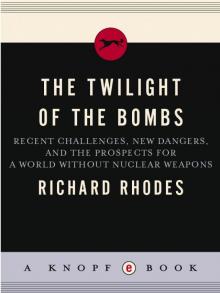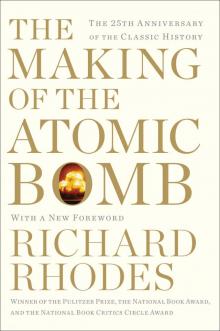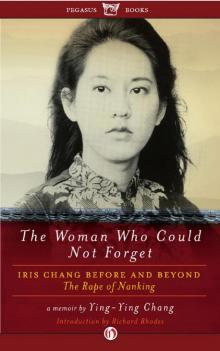- Home
- Richard Rhodes
The Twilight of the Bombs
The Twilight of the Bombs Read online
ALSO BY RICHARD RHODES
Arsenals of Folly
The Audubon Reader
John James Audubon
Masters of Death
Why They Kill
Visions of Technology
Deadly Feasts
Trying to Get Some Dignity
(with Ginger Rhodes)
Dark Sun
How to Write
Nuclear Renewal
Making Love
A Hole in the World
Farm
The Making of the Atomic Bomb
Looking for America
Sons of Earth
The Last Safari
Holy Secrets
The Ungodly
The Ozarks
The Inland Ground
FOR THOMAS GRAHAM, JR.
A grant from the John D. and Catherine T. MacArthur Foundation supported the research and writing of this book.
The problem of nuclear weapons is nuclear weapons.
RICHARD BUTLER
CONTENTS
Cover
Other Books by this Author
Title Page
Dedication
Epigraph
Prologue: A Different Country
PART ONE FOLLOWING THE CALUTRON TRAIL
1 “President Bush’s Frankenstein”
2 Cutting Saddam’s Sinews
3 True Courage
4 Following the Calutron Trail
PART TWO BREAKDOWN AND REFORMATION
5 The Little Suitcase
6 Many Little Monsters
7 Waiting for Forty Years
PART THREE COMING IN FROM THE COLD
8 Preventive Defense
9 Leaving the Laager
10 A Million and a Trillion
11 Great Leaders
12 The Cornerstone of Peace and Stability
13 The Dog Ate My Homework
PART FOUR AN INTOLERABLE THREAT TO ALL HUMANITY
14 Regime Change
15 The Hard Stare into the Abyss
16 The Twilight of the Bombs
Notes
Bibliography
Acknowledgments
Permissions Acknowledgments
Illustration Credits
Photo Insert
A Note About the Author
Copyright
PROLOGUE
A DIFFERENT COUNTRY
It did not take atomic weapons to make war terrible.… It did not take atomic weapons to make man want peace, a peace that would last. But the atomic bomb was the turn of the screw. It has made the prospect of future war unendurable. It has led us up those last few steps to the mountain pass; and beyond there is a different country.
ROBERT OPPENHEIMER, 1946
WHEN THE ICE BROKE on the river of history in the final years of the Cold War, the world had lived with nuclear weapons for almost half a century. Forty nations had attained the capability to build them, but only nine had yet done so: the United States, the Soviet Union, Britain, France, China, Israel, India, Pakistan, and South Africa. Together, these nine nations had accumulated about sixty thousand nuclear weapons—about three thousand pounds of explosive force for every man, woman, and child on earth, more than enough to destroy the human world. Their reasons for going nuclear varied from the United States’s conviction that only nuclear weapons could protect the West from a Communist empire it believed to be bent on world domination, to the Soviet Union’s belief that it stood surrounded by enemies and alone in a hostile world, to France’s and Britain’s doubts that the United States would make itself a nuclear target to come to their aid, to South Africa’s curious notion that brandishing a small nuclear arsenal should it be attacked by other African states would compel the major nuclear powers to intervene on its behalf.
Yet in all the years since the first two atomic bombs destroyed the Japanese cities of Hiroshima and Nagasaki at the end of the Second World War, no more nuclear weapons had been exploded in anger. Those who believed in deterrence, in the power of the bombs to prevent their use, naturally believed that half a century free from major war meant that deterrence had worked—and, by extension, should continue to work in perpetuity. Those who doubted the efficacy of deterrence noted that both the United States and the Soviet Union had accepted stalemate, as in Korea, or even defeat, as in Vietnam and Afghanistan, rather than risk nuclear escalation. Nuclear arsenals might promote caution in relations among hostile states, the doubters therefore argued, but they clearly did not compel, while a world awash with tens of thousands of nuclear weapons gravely risked accidental or inadvertent nuclear holocaust.
During the Cold War most of the nations of the world had aligned themselves with one or the other superpower, freezing into place the contending hegemonies that had followed from the victories and defeats of the Second World War. With the warming of relations between the United States and the Soviet Union initiated by the Soviet reformer Mikhail Gorbachev in the 1980s, that seizure of international relations began to release.
At a summit meeting between Gorbachev and the U.S. president Ronald Reagan in Reykjavik, Iceland, in 1986, the two leaders had come close to agreeing to lead the world to the complete elimination of nuclear weapons. To that purpose Gorbachev had championed common security, a principle formulated out of Europe’s Cold War experience of zero-sum division between East and West. As a United Nations commission chaired by the Swedish prime minister Olof Palme had defined it in a 1982 report, “The principle of common security1 asserts that countries can only find security in cooperation with their competitors, not against them.” In a speech to the 27th Soviet Communist Party Conference early in 1986, Gorbachev had applied the principle to the ongoing nuclear arms race between the Cold War antagonists. “The task of insuring security,”2 he told the delegates, “is more and more taking the form of a political task and can be resolved only by political means.… In our time, genuine equal security is guaranteed not by the highest possible but by the lowest possible level of strategic balance, from which it is essential to exclude entirely nuclear and other types of weapons of mass destruction.” Reagan, however, believed that only physical security in the form of space-based antimissile defenses could guarantee nuclear disarmament. The Soviet government was not prepared to undertake such an expensive and ultimately chimerical technological competition, and the agreement on nuclear elimination failed. Reykjavik was not fruitless, however; it put both sides’ commitment to nuclear-arms reductions, rather than merely arms control, firmly on the table, and led directly to the 1987 Intermediate Nuclear Forces Treaty, which eliminated an entire class of particularly destabilizing nuclear weapons carried on 2,692 U.S. and Soviet medium-range missiles.
Despite their seemingly implacable differences, the two superpowers had worked both separately and jointly during the Cold War to limit nuclear proliferation, implicitly cooperating for common security. Their most significant cooperation drove the negotiation of the Nuclear Nonproliferation Treaty (NPT), opened for signature in 1968, which offered extensive security guarantees and the advantages of commercial nuclear power to countries willing to forgo acquiring nuclear arsenals; by 1990, 140 states had signed on. More than any other factor, the NPT had limited the proliferation of nuclear weapons across the world.
Actions had also been directed against specific states. In 1975 a threat by the United States to withdraw its military forces from the Korean Peninsula had compelled South Korea to abandon its program of nuclear-weapons development. In 1976 and again in 1987, partly under pressure from the People’s Republic of China, the United States had forced Taiwan3 to abandon clandestine nuclear weapons programs. Satellite images indicating an impending South African nuclear test that the Soviet Union passed to the
United States for timely action in 1977 led to intense U.S. diplomatic pressure that delayed the South African nuclear weapons program by several years.
But the very predominance in nuclear weapons that the two superpowers had achieved had worked against their security. Neither side had been sufficiently confident of the authority of its nuclear arsenal to limit itself to minimum deterrence, as China had done, and both the Soviet and American military-industrial complexes had taken advantage of that uncertainty to repeatedly expand and modernize their nations’ nuclear arsenals. Actions that were justified domestically as defensive were perceived by the other side to be hostile. In 1983, shaken by the Reagan administration’s belligerent military buildup, and misjudging the intent of a major NATO field exercise in West Germany called Able Archer, which included a practice run-up to nuclear war, the Soviet leadership under Yuri Andropov had very nearly launched a preemptive nuclear strike against the United States. Though it all but escaped public notice, the Able Archer incident was the Cuban Missile Crisis of its day. By the time Gorbachev came to power in 1985, both sides threatened each other with total and mutual annihilation. “If one country keeps4 building weapons while the other one doesn’t do a thing,” Gorbachev told Richard Nixon in the summer of 1986, “the one that arms will not gain anything from it. The weaker party could just explode its nuclear stockpile, even on its own territory, which would mean suicide for it and a slow death for the opponent.”
The progress at Reykjavik, and the arms proposals that Gorbachev offered in its aftermath, foundered on American suspicions of Soviet intentions, but gradually, during the presidency of George H. W. Bush, through the good offices of Secretary of State James A. Baker III and the Soviet foreign minister Eduard Shevardnadze, relations began to warm. That improvement prepared the way for cooperation between the two former enemies to beat back the aggression of Iraqi president Saddam Hussein, who misread the Reagan and Bush administrations’ tilt toward his country and against its enemy Iran as license to plunder Kuwait and threaten Saudi Arabia, a prime U.S. client. By the time the Persian Gulf War ended, in February 1991, however, the struggle for power in the Soviet Union was straining Gorbachev’s control and the Soviet economy was collapsing. After a coup attempt against the beleaguered Soviet leader the following August, U.S. policy shifted from support to salvage. When the Soviet Union fractured into fifteen independent nations on 25 December 1991, one nuclear power suddenly metastasized into four—Russia, Belarus, Ukraine, and Kazakhstan—each with substantial nuclear arsenals. Thereafter the United States scrambled to support the consolidation of the former superpower’s nuclear weapons on Russian soil, to subsidize the scientists and engineers of the former Soviet nuclear weapons complex, and to secure nuclear materials dispersed in manufactories and institutes across eleven time zones.
The example of the superpowers’ nuclear arms race had not been lost on smaller nations. The overwhelming majority had the good sense to recognize that mutual security under the NPT would spare them a financial burden and keep them safe. A few, stigmatized by the international community for their repressive policies or locked into long-standing conflicts, concluded that nuclear weapons could protect them from conventional as well as nuclear attack and even secure them a place at the banquet table of the superpowers. India, pursuing a nuclear option after losing a border war with China in 1962, tested a first-generation nuclear weapon underground in 1974 (calling it a “peaceful nuclear explosive”) but then confined itself to research and plutonium stockpiling until the 1990s. Pakistan, after losing a devastating war with India in 1971, began developing a uranium-enrichment program for nuclear weapons with Chinese technical support. In the early 1980s, China supplied Pakistan with a simple and sturdy bomb design, and allowed its ally to test its first nuclear weapon at a Chinese test site, Lop Nur,5 in May 1990. Pakistan too would extend development of its nuclear arsenal in the 1990s.
Iraq, in contrast, pursued nuclear weapons initially as a shield against Iran, with which it fought a devastating war between 1980 and 1988, and subsequently against Israel and the United States.
North Korea first sought nuclear-power reactors from the Soviet Union to replace the hydroelectric capacity it had lost almost totally to American strategic bombing during the U.S.-Korean War of 1950 to 1953. Repeatedly rebuffed by its Cold War patron, its leader, Kim Il Sung, authorized an indigenous nuclear power and weapons program in 1979; the weapons program was intended to produce a deterrent to the arsenal of U.S. tactical nuclear weapons positioned in South Korea and to compel the United States to negotiate. A five-megawatt gas-graphite-type nuclear reactor went critical at the North’s research center at Yongbyon in 1986 and began breeding plutonium in the course of its operation. By 1990, U.S. satellite surveillance had revealed that North Korea was building a plutonium-separation facility at Yongbyon as well.
The 1968 Nuclear Non-Proliferation Treaty had been an exception to the rule that treaties are usually ratified indefinitely—that is, permanently, without a termination date. The nonnuclear signatories had been concerned that the five nuclear powers grandfathered into the treaty would fail to reduce their arsenals or work actively for nuclear disarmament, and that the treaty’s safeguards requirements would put countries without nuclear power at a commercial disadvantage. These concerns had led them to insist that the NPT should be reviewed after twenty-five years and then either indefinitely extended or extended only for a limited term or terms. Since the treaty had entered into force in 1970, two years after it had been opened for signature, this review and extension conference was scheduled for 1995.
Yet only five years prior to that deadline, as protective Cold War alliances fell away, a new wave of nuclear proliferation appeared to be surging through the second and third tier of nations. At the same time, the unfettering and simultaneous impoverishing of the Soviet Union had opened the world’s largest nuclear arsenal—previously secure within borders guarded by barbed wire and minefields—to theft or criminal diversion. In Nuclear Ambitions, a study published in 1990 subtitled The Spread of Nuclear Weapons 1989–1990, the nonproliferation expert Leonard Spector worried about the proliferation tendencies he saw evolving:
Despite certain promising developments6 during 1989 and 1990 in the field of nuclear non-proliferation, a number of disturbing trends in this area point to the need for continued vigilance and intensified international efforts to curb the spread of nuclear weapons. Even as the risk of nuclear confrontation between the superpowers has diminished, for example, concerns have increased that conflict may erupt between the two de facto nuclear powers in South Asia [i.e., India and Pakistan], a conflict in which nuclear weapons would inevitably play a role. Similarly, as hopes have been raised that South Africa may join the NPT and thereby reduce the number of states outside the international non-proliferation regime, anxieties have increased over the nuclear intentions of North Korea and Iraq and over the commitments of these two NPT parties to the treaty.… Argentina and Brazil have undertaken important confidence-building measures through their exchanges of visits to nuclear facilities, but fears of unconventional warfare continue to mount in the Middle East, as evidenced by Iraqi President Saddam Hussein’s threats to destroy half of Israel with chemical weapons, if attacked, and by Israel’s threats to respond to such an act a hundred times over.
These trends implied that for all the elation and fresh energy that followed the release of Eastern Europe and the Soviet people themselves from Communist authoritarianism, the post–Cold War era might be more hazardous than the Cold War years had been. While the threat of global nuclear war between two hostile superpowers had faded, the risk of regional nuclear war among nations with seemingly modest nuclear arsenals had intensified. A regional nuclear war between India and Pakistan, for example, would be unlikely to involve more than about one hundred Hiroshima-scale fifteen-kiloton weapons, merely 1.5 megatons of total explosive force, less than the yield of many individual Soviet and U.S. hydrogen bombs. The primary destructive ef
fect of nuclear weapons is mass fire, however, and with highly combustible South Asian megacities as the likeliest targets, such a nuclear exchange would kill between three million and sixteen million people. Smoke from mass fires would loft into the stratosphere, drift around the world, and darken and chill the earth for a decade, reducing global average temperatures below those of the European Little Ice Age of the sixteenth to mid-nineteenth centuries, when crops failed and millions starved. Even a “small” regional nuclear war, that is, would be an unmitigated disaster for the entire world.7
Yet Spector’s catalog of dangerous trends incorporated only a limited view of post–Cold War challenges and opportunities. Another perspective revealed realistic opportunity in the last decade of the twentieth century and the first decade of the twenty-first to move toward drastic reductions in the number of nuclear weapons in the world, down to minimum deterrence or even to zero. Both the United States and the former Soviet Union, for example, undertook a radical withdrawal and reduction of their nuclear arsenals. Both sides endorsed and supported the indefinite extension of the Nuclear Nonproliferation Treaty. Both sides supported and signed the Comprehensive Nuclear Test-Ban Treaty, although conservative Republicans in the U.S. Senate bent on discrediting President Bill Clinton prevented its American ratification in 1999.
Before governments could act responsibly to eliminate nuclear arsenals, a debate among government and public organizations throughout the world was necessary to test the logic and work out the process of doing so. That debate opened in the 1990s in the context of securing the nuclear remnants of the former Soviet Union, aiding states with nuclear ambitions in abandoning those ambitions, and coercively dismantling the nuclear infrastructure of Iraq. Those in the U.S., France, Britain, and Russia who believed nuclear weapons armored their national sovereignty vociferously defended nuclear possession for deterrence even as proponents of nuclear elimination, including many military leaders, identified the weapons themselves as the fundamental danger. “As long as any state has nuclear weapons,”8 Australia’s 1996 Canberra Commission on the Elimination of Nuclear Weapons postulated, “others will seek to acquire them.”

 The Twilight of the Bombs
The Twilight of the Bombs Hedy's Folly
Hedy's Folly Making of the Atomic Bomb
Making of the Atomic Bomb Woman Who Could Not Forget
Woman Who Could Not Forget